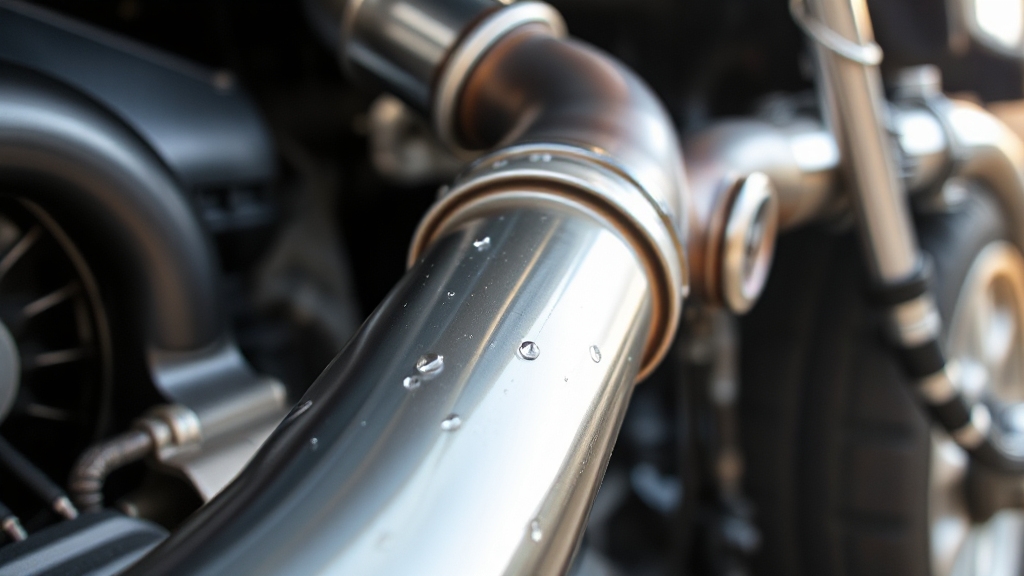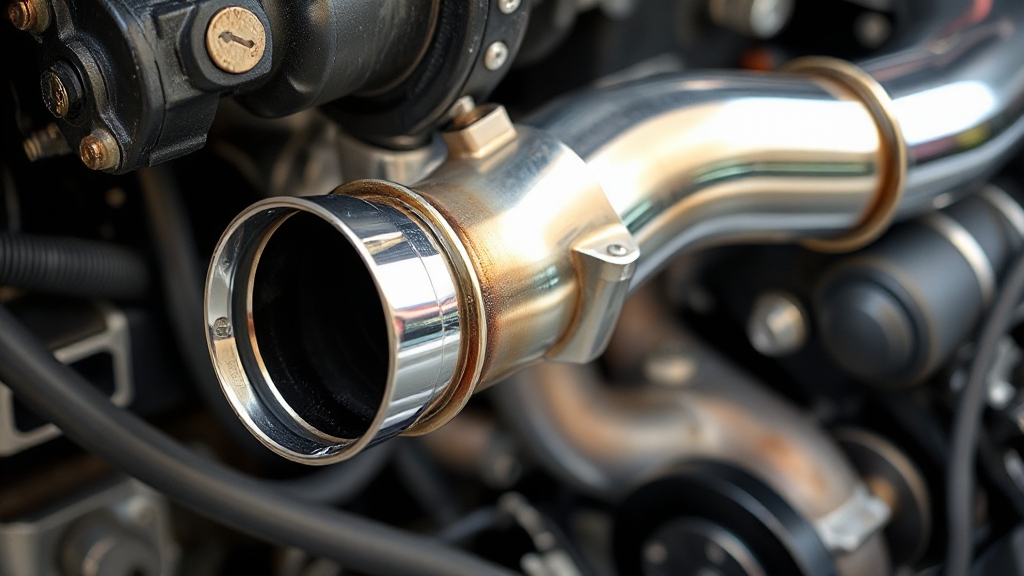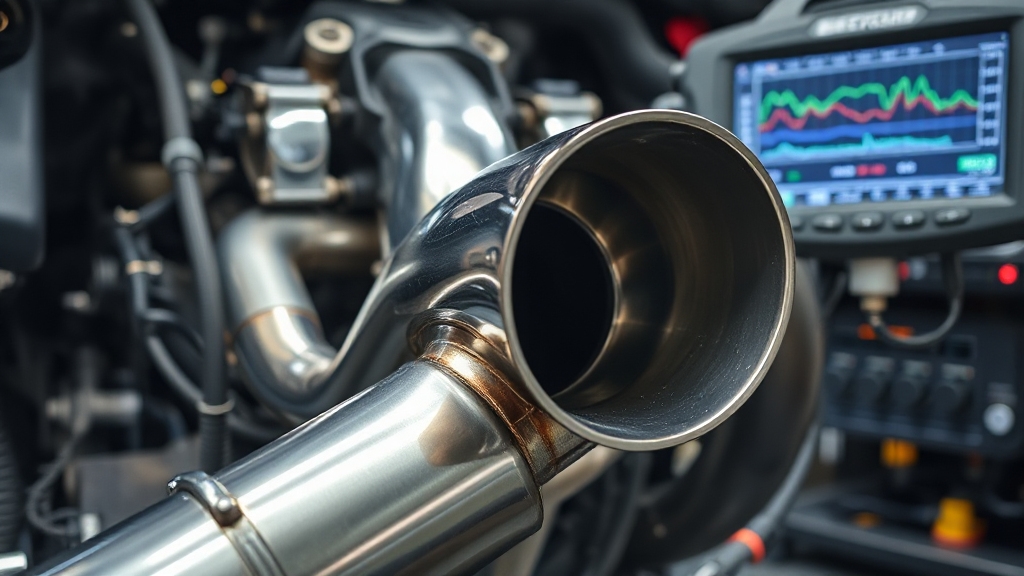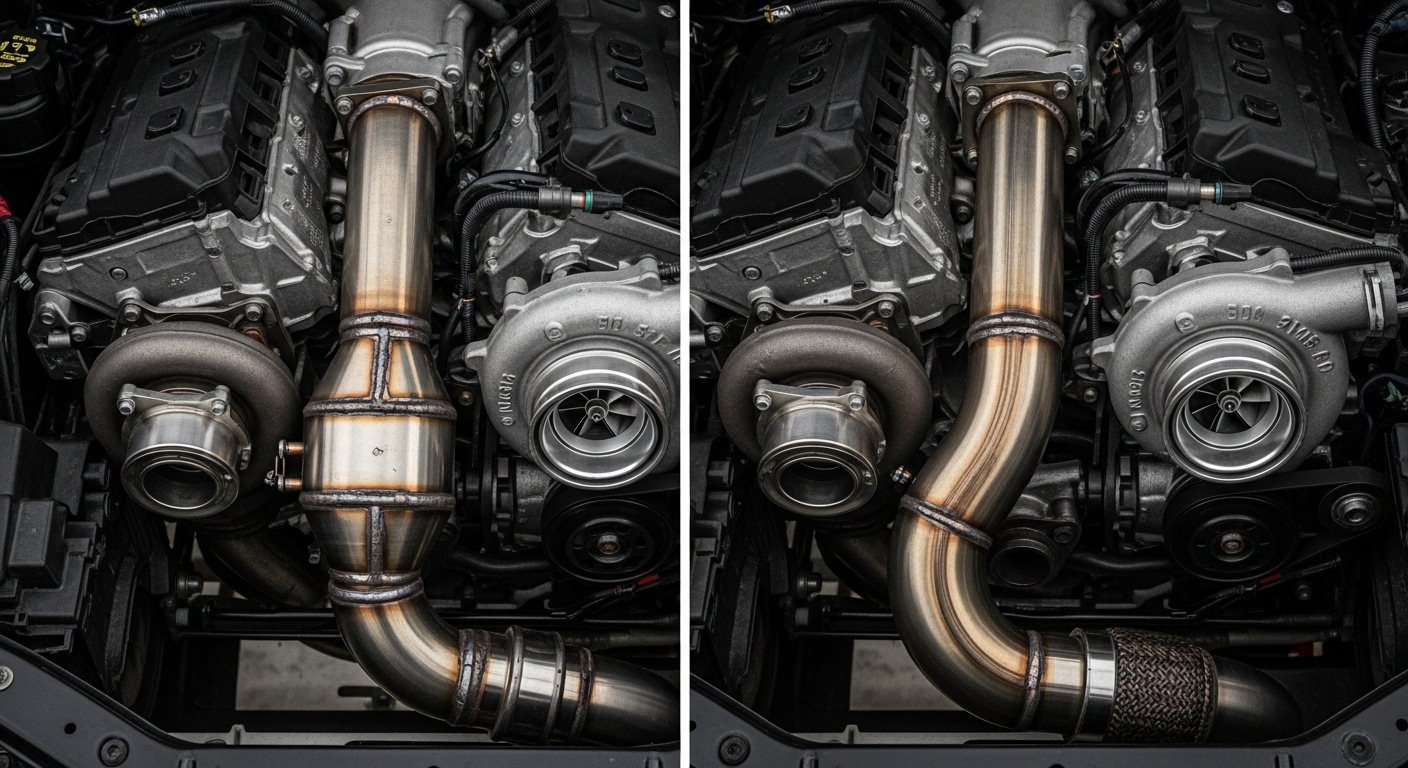You need a tune after installing a downpipe to optimize your engine’s air-fuel ratio and prevent check engine lights from triggering. Without tuning, altered exhaust flow can cause poor performance, increased emissions, and sensor errors. A proper ECU calibration maximizes horsepower gains, improves turbo response, and ensures reliable operation while maintaining emissions compliance where required. Upgrading without tuning risks engine damage and legal trouble. Understanding the technical and legal impacts can help you make informed decisions for your vehicle.
Key Takeaways
- A tune is typically required after installing a downpipe to optimize air-fuel ratios and maximize performance gains.
- Without tuning, the ECU may trigger a Check Engine Light due to altered exhaust flow and sensor readings.
- Proper ECU calibration prevents engine damage, reduces turbo lag, and improves throttle response with the downpipe upgrade.
- Catless downpipes almost always need a tune to avoid emissions failures and legal issues.
- A catted downpipe may not require tuning but still benefits from ECU adjustments for best efficiency and reliability.
Purpose and Function of a Downpipe

How does a downpipe impact your vehicle’s exhaust system? It directs exhaust gases from the turbocharger turbine housing to the rest of the exhaust, serving as the first critical section post-turbo.
Bolting directly to the turbine housing, it incorporates a flange for turbo connection and threaded ports for lambda sensors to monitor emissions. Proper installation and maintenance of the downpipe are essential to prevent potential engine issues related to exhaust flow and sensor function.
The downpipe often includes a flexible section that reduces vibrations and mechanical stress during acceleration, preserving system durability.
It contains one or more catalytic converters essential for filtering pollutants and meeting emissions standards, though these introduce flow restrictions.
Constructed with mandrel bent tubing and designed for tight fitting, the downpipe ensures smooth exhaust flow, reduces backpressure, and manages heat and pressure changes, balancing emissions compliance with efficient exhaust evacuation in turbocharged vehicles.
This section is typically made from stainless steel or high-performance materials to withstand the high temperatures and pressures of exhaust gases. Upgrading to a high-quality downpipe can improve exhaust flow and overall engine performance.
How a Downpipe Improves Engine Performance?
When you upgrade to a performance downpipe, you markedly enhance exhaust flow by reducing backpressure. This allows gases to exit the engine more efficiently and can complement upgrades such as high-performance air filters to maximize airflow.
This improved flow directly boosts turbocharger efficiency by enabling faster spool-up and minimizing turbo lag. As a result, your engine responds quicker and delivers power more smoothly across the RPM range.
Selecting a downpipe made from high-quality materials like stainless steel or titanium ensures durability and optimal performance, making it a wise choice for any serious enthusiast seeking long-lasting upgrades.
Exhaust Flow Enhancement
Although stock downpipes serve their purpose, upgrading to a performance downpipe considerably enhances exhaust flow by reducing back pressure and increasing the diameter through which gases escape. This larger diameter and less restrictive design allow exhaust gases to exit more freely, minimizing resistance and preventing power loss.
Similar to how high-performance brake fluids like Castrol SRF maintain reliability under stress, a quality downpipe ensures consistent engine performance under demanding conditions by improving exhaust efficiency.
By improving exhaust evacuation, the engine experiences reduced strain, which directly translates to increased horsepower and torque. The smoother airflow also supports quicker turbo response by enabling faster spool-up times, enhancing throttle precision and acceleration. This improvement helps reduce turbo lag and provides a more responsive driving experience due to enhanced turbocharger response.
Additionally, efficient exhaust flow optimizes combustion by stabilizing the air-fuel mixture, which can improve fuel efficiency during steady driving. Ultimately, a high-quality downpipe upgrade ensures better engine breathing, delivering consistent power gains while maintaining overall system efficiency. Proper component selection, much like choosing the right brake fluid composition, is crucial for sustaining long-term engine health and performance.
Turbocharger Efficiency Boost
Because a downpipe substantially reduces exhaust backpressure, it directly boosts your turbocharger’s efficiency. By providing a less restrictive path for exhaust gases, the turbo can spool faster, increasing boost pressure and enhancing power output.
Choosing the right synthetic oil can also ensure your turbocharged engine maintains optimal performance under increased stress, as high-quality oils like Mobil 1 offer superior wear protection for turbo components.
This reduction in backpressure also improves your turbo’s ability to process exhaust gases more effectively, which sharpens throttle response and elevates horsepower and torque, especially at lower to mid RPMs. Additionally, the quicker spool-up time reduces turbo lag, resulting in more immediate power delivery and better acceleration.
Many turbocharged vehicles can see horsepower gains of approximately 15-30 HP from this upgrade, especially when combined with ECU tuning that optimizes air-fuel ratio and timing, further enhancing performance horsepower gains.
These gains translate into improved drivability and throttle sensitivity. Optimizing your downpipe’s design and pairing it with proper ECU tuning guarantees that you maximize these efficiency benefits safely and reliably, releasing the full potential of your turbocharged engine.
Risks of Installing a Downpipe Without a Tune

If you install a downpipe without tuning, you’ll likely trigger a Check Engine Light due to unoptimized sensor feedback and fuel trims.
This can degrade engine performance and fuel efficiency since the ECU won’t adjust for altered exhaust flow. However, running a catted downpipe generally does not require a tune and results in minimal or no check engine lights due to its catalyst retention.
Additionally, you risk failing emissions tests and violating regulations, especially with catless downpipes that affect catalytic converter function.
Check Engine Light
Why does your check engine light (CEL) turn on after installing an aftermarket downpipe? The ECU detects anomalies in exhaust parameters, especially from the secondary O2 sensor, which sends irregular signals due to altered flow dynamics.
This triggers emissions-related trouble codes like P0402, indicating EGR system issues. These trouble codes are part of the onboard diagnostics system alerting you to potential engine or emissions faults.
While these codes mightn’t immediately impact drivability, they represent non-compliance with factory settings and can persist despite attempts to clear them via OBD2 readers. Installing aftermarket downpipes may also violate emissions laws, leading to potential legal and inspection issues.
To reduce CEL triggers, many install O2 sensor spacers that modify sensor readings without ECU tuning. However, spacers may not fully resolve compliance concerns or sensor irregularities.
The most reliable solution involves ECU calibration to adjust fuel maps and sensor parameters, preventing persistent CELs and potential limp mode activation.
Performance Degradation Risks
When you install a downpipe without tuning your ECU, you risk causing significant performance issues due to unadjusted fuel-air mixtures, altered exhaust backpressure, and increased turbocharger stress. Choosing components that meet OEM standards can help mitigate some risks but does not replace the need for tuning.
The altered exhaust flow disrupts factory fuel maps, leading to improper air-fuel ratios that reduce combustion efficiency and can cause knocking or carbon buildup.
Without tuning, reduced backpressure changes turbo spool characteristics, often causing torque dips and erratic power delivery. Proper ECU tuning is critical to maintain optimal air-fuel ratios and prevent engine damage.
Additionally, increased exhaust gas temperatures strain turbo components, accelerating wear and risking premature failure. Heat buildup may degrade engine bay parts, while sensor data inconsistencies can trigger limp mode or diagnostic errors. Regular maintenance and quality parts can help manage these stresses to extend component longevity.
Emissions Compliance Issues
Although installing a downpipe without tuning may seem like a straightforward performance upgrade, it often leads to significant emissions compliance issues.
Removing or bypassing the catalytic converter typically results in higher pollutant emissions, causing your vehicle to fail mandatory state or federal emissions tests. This failure can trigger legal penalties and restrict your vehicle’s registration and road use. Improper modifications can also negatively impact vehicle handling and stability.
When considering a downpipe install, keep these points in mind:
- Catless downpipes usually cause failed emissions inspections due to the lack of catalytic converters, especially in states with strict standards like California.
- Untuned ECU settings can cause persistent check engine lights, alerting inspectors to modifications.
- Non-compliance risks fines, vehicle registration denial, and environmental harm due to increased toxic emissions.
Proper tuning and emissions-compliant components are essential to avoid these issues. Additionally, engine management adjustments are often required post-installation to prevent error codes and optimize performance.
The Role of ECU Calibration in Downpipe Upgrades

Since downpipe upgrades substantially alter exhaust flow characteristics, ECU calibration plays a vital role in optimizing engine performance and reliability. By adjusting air-fuel ratios, the ECU prevents lean conditions that risk engine damage. Upgrading to a high-quality stainless steel downpipe ensures durability and complements the ECU tuning process for maximum efficiency.
Calibration accounts for increased exhaust flow, enabling the turbocharger to spool faster, reducing lag, and releasing 5-20 horsepower gains depending on your vehicle and mods.
It also refines fuel maps to guarantee smooth throttle response and consistent torque delivery with the freer-flowing exhaust. Modern ECU tuning often includes adjustments to ZDDP levels for enhanced engine wear protection.
Without recalibration, oxygen sensor readings may trigger check engine lights or cause drivability issues. ECU tuning methods range from basic remaps to custom dyno calibrations, balancing power enhancements with engine safety.
Professional tuning is essential to harmonize boost control, fuel timing, and sensor management, maximizing your downpipe’s potential while protecting the engine.
Emissions and Legal Considerations With Aftermarket Downpipes
Modifying your vehicle’s downpipe directly impacts emissions compliance and legal standing, especially in regions with strict regulations like California. Installing a catless downpipe often results in failing smog checks due to removed catalytic converters, violating both state laws and the Clean Air Act.
California Air Resources Board (CARB regulations) require aftermarket parts to be certified to be legal for street use. Choosing components made from impact-resistant plastics can also help ensure durability and reduce maintenance concerns.
To navigate these challenges, consider the following:
- Use CARB-certified downpipes with high-flow catalytic converters to maintain legality and reduce emissions.
- Ensure proper ECU tuning to prevent Check Engine Light triggers and comply with emissions standards.
- Understand your state’s specific emissions laws, as enforcement and requirements vary considerably.
Ignoring these factors can lead to fines, registration refusals, and increased pollution.
Balancing performance upgrades with emissions compliance safeguards your investment and helps you avoid legal complications.
Technical Benefits of Larger Diameter Downpipes
Balancing emissions compliance with performance gains often leads you to contemplate the technical advantages of upgrading to larger diameter downpipes. By increasing the cross-sectional area, these downpipes reduce exhaust flow restriction and back pressure, enabling gases to exit the turbocharger more efficiently.
This improved flow accelerates exhaust evacuation, enhancing engine breathing and turbocharger efficiency. Consequently, you experience increased horsepower and torque—typically a 10-20 hp gain—without major engine modifications. It also reduces turbo lag, improving throttle response and overall engine performance.
Larger downpipes also reduce turbo lag by speeding up spool times, improving throttle response and drivability. Additionally, their construction with high-grade stainless steel and mandrel bending enhances durability and heat management, mitigating thermal stress and corrosion. These material choices contribute to long-term performance by resisting wear and maintaining structural integrity under extreme conditions.
User Experiences: Tuning Versus No Tuning
When you upgrade your downpipe, choosing to tune your vehicle’s engine management system can substantially influence performance outcomes. Users consistently report measurable improvements with tuning, including:
- Power and Responsiveness: Tuning typically yields 5-10% horsepower gains, smoother engine response, reduced turbo lag, and more immediate acceleration. This is largely because a downpipe features a larger diameter that reduces exhaust back pressure, allowing the engine to breathe more efficiently.
- Exhaust Acoustics: Tuned downpipes produce a deeper, richer exhaust note with less unwanted drone compared to untuned setups.
- Fuel Efficiency and Emissions: Optimized tuning improves combustion efficiency, marginally enhances fuel economy, and helps maintain emissions compliance by preventing check engine lights and error codes.
Without tuning, you risk suboptimal air-fuel ratios, increased emissions, and diminished performance gains. Therefore, tuning maximizes the functional and acoustic benefits of a downpipe upgrade, ensuring reliable, efficient operation.
Best Practices for Combining Downpipes With Engine Tuning
Because upgrading your downpipe considerably alters exhaust flow and engine dynamics, combining it with precise engine tuning is essential to fully realize performance gains and maintain reliability.
Start by ensuring a leak-free exhaust system post-installation, as leaks can skew sensor readings and compromise tuning accuracy. The downpipe connects the exhaust manifold to catalytic converter, channeling gases downstream efficiently to reduce back-pressure. Use professional tuners or verified software tailored to your specific downpipe and vehicle to adjust air-fuel ratios, boost control, and ignition timing precisely.
Monitor engine parameters closely after tuning to detect any anomalies early. Follow manufacturer torque specs during installation to prevent mechanical issues that affect performance.
Finally, schedule periodic retuning to adapt to wear and environmental changes, ensuring sustained efficiency and safety. This integrated approach balances enhanced power output with engine longevity and compliance.
Frequently Asked Questions
How Does Downpipe Material Affect Heat Management and Durability?
You’ll find that downpipe material directly impacts heat management and durability. Stainless steel, especially 304-grade, resists corrosion and withstands high temperatures better than cheaper alloys that rust and warp.
Ceramic coatings and exhaust wraps help retain heat, boosting turbo efficiency and protecting components.
Thicker walls improve heat tolerance and reduce cracking, while metallic catalytic substrates resist thermal stress better than ceramic ones, ensuring longer-lasting performance under extreme conditions.
Can a Downpipe Tune Improve Fuel Economy as Well as Power?
Yes, a downpipe tune can improve fuel economy alongside power. By reducing exhaust backpressure, you enable your engine to breathe better, working more efficiently.
The ECU tune adjusts air-fuel ratios and timing, optimizing combustion for both performance and economy. However, gains depend on your driving habits—steady driving maximizes mileage improvements, while aggressive throttle use may offset fuel savings.
Proper professional tuning guarantees balanced power and efficiency benefits.
What Are Signs That My Vehicle Specifically Needs a Downpipe Tune?
You’ll know your vehicle needs a downpipe tune if the Check Engine Light stays on after installation, or if you experience rough idling, misfires, or decreased fuel efficiency.
Notice any hesitation, loss of power, or inconsistent turbo boost? Those are clear signs, too.
Additionally, if you detect unusual exhaust smells or increased engine temperatures, your ECU likely requires recalibration to optimize air-fuel ratios and prevent engine damage.
Are There Specific Downpipe Tunes Optimized for Daily Driving Versus Racing?
Think of downpipe tunes like choosing between a smooth jazz playlist for a chill evening and heavy metal for a high-energy workout. You’ll find daily driving tunes prioritize smooth power delivery, emissions compliance, and comfort, optimizing for fuel efficiency and minimal noise.
Racing tunes, on the other hand, crank up ignition timing, boost, and fuel richness for maximum power and quicker turbo spool, sacrificing some comfort and fuel economy for aggressive performance on the track.
How Often Should a Downpipe Tune Be Updated or Recalibrated?
You should update or recalibrate your downpipe tune based on driving conditions, modifications, and emissions requirements. Typically, tune updates align with major maintenance intervals like oil changes every 5,000–8,000 miles.
Watch for check engine lights, diagnostic codes, or performance changes as triggers. Aggressive driving and added exhaust parts also necessitate more frequent recalibration.
Consulting a professional tuner ensures your tune remains ideal and compliant with regulations.
The Final Word: Tuning is the Key to Reliable Power
If you’re installing a downpipe, skipping a tune is like driving with one foot on the brake—your engine won’t perform at its best. Tuning recalibrates your ECU to optimize air-fuel ratios and prevent issues like check engine lights or power loss. For maximum gains, better efficiency, and legal compliance, pairing your downpipe with proper tuning isn’t just recommended; it’s essential to unleash your engine’s full potential safely and reliably.




